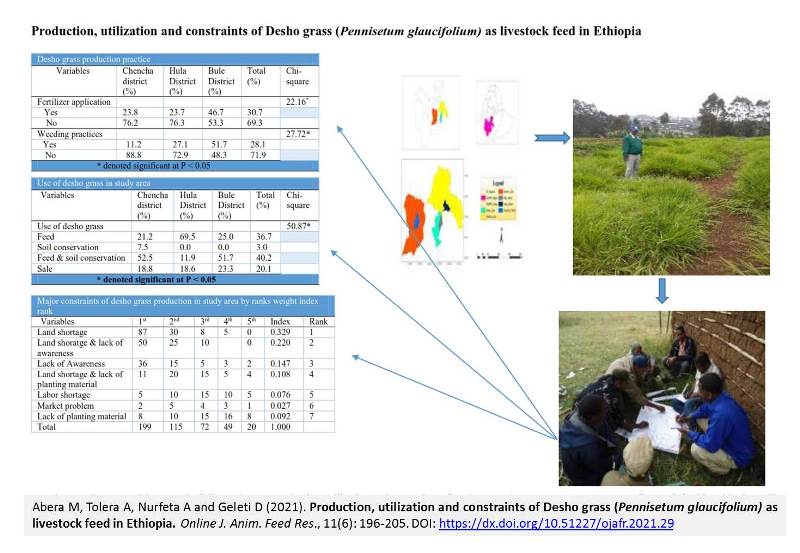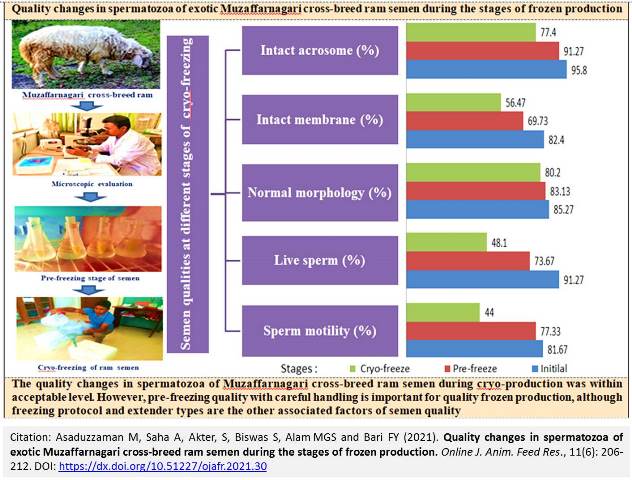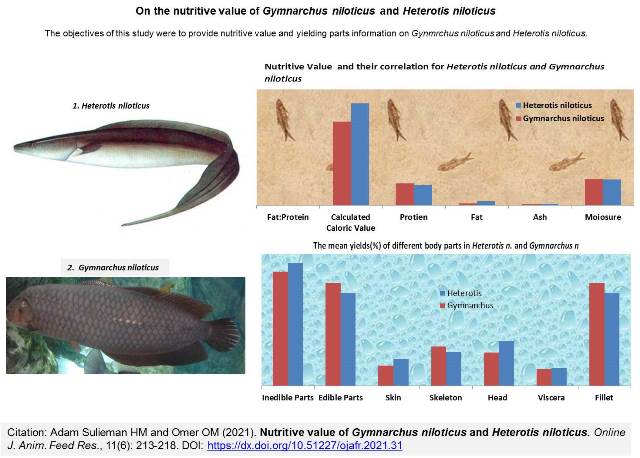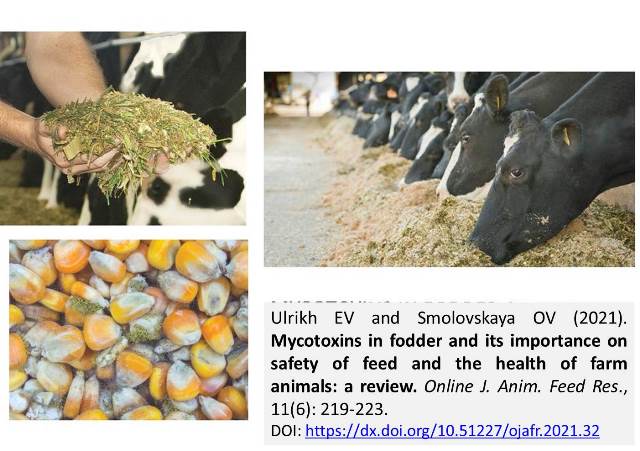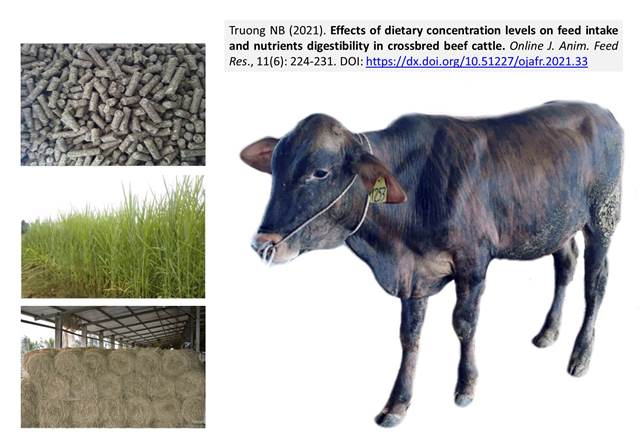Previous issue | Next issue | Archive
![]() Volume 11 (6); November 25, 2021 [Booklet] [EndNote XML for Agris]
Volume 11 (6); November 25, 2021 [Booklet] [EndNote XML for Agris]
Production, utilization and constraints of Desho grass (Pennisetum glaucifolium) as livestock feed in Ethiopia
Abera M, Tolera A, Nurfeta A and Geleti D.
Online J. Anim. Feed Res., 11(6): 196-205, 2021; pii: S222877012100029-11
DOI: https://dx.doi.org/10.51227/ojafr.2021.29
Abstract
The study was conducted with the objective of assessing farmers’ production practice, utilization and constraints of Desho grass (Pennisetum glaucifolium) production in Chencha, Bule and Hula districts, Ethiopia. The methodology of this study encompassed questionnaire survey and group discussion. Simple random sampling was used to select a sample consisting of 199 households in the districts. The collected data were analyzed by SPSS and SAS software. The result indicated that of the total respondents, 69% did not used fertilizer and 72% respondents not practiced weeding, Generally, the majority of respondents, did not use any forage improvement practice after plantation. Concerning forage utilization, 48.2, plant Desho as soil band, while 26.6% plant as hedgerows and 25.1% plant in the back yard. 40.2 % of the respondents reported that they plant Desho grass for both feeding animals and soil conservation, while the remaining 36.7% plant Desho only for feeding animals, 20% plant Desho gras for sale and 3% plant Desho grass for only soil conservation. Based on the laboratory result, Desho grass is classified as high quality feedstuff for the study area. The crude protein, neutral detergent fiber, acid detergent fiber, acid detergent lignin content and in vitro organic matter digestibility of sample Desho grass was 7.04, 72.47, 43.73, 5.4 and 52.19 percent, respectively. Land shortage and lack of awareness were ranked first and second constraints for Desho production in the study area. It can be conclude that, Desho grass have a very important function in terms of contribution of nutrients to livestock and locally available feed resource however, farmers are not getting the benefits they deserve from the use of Desho grass, which has not been improved and should be supported by research to improve it production and use.
Keywords: Desho grass, Feed, Forage, Production practice, Utilization.
[Full text-PDF] [Scopus] [ePub] [Export from ePrint] [Export citation to RIS & EndNote] [How to Cite]
Quality changes in spermatozoa of exotic Muzaffarnagari cross-breed ram semen during the stages of frozen production
Asaduzzaman M, Saha A, Akter, S, Biswas S, Alam MGS and Bari FY.
Online J. Anim. Feed Res., 11(6): 206-212, 2021; pii: S222877012100030-11
DOI: https://dx.doi.org/10.51227/ojafr.2021.30
Abstract
Good quality frozen semen is a prerequisite for successful artificial insemination. Changes in the quality of sperm structure incur during semen processing of cryo-production. The current study, is, therefore, designed to evaluate the Muzaffarnagari cross-breed ram sperm at the fresh diluted stage, pre-freeze, and after freezing stages of frozen production. The semen collected was enlarged to include the A-part of 37°C egg yolk media. After cooling to 5ºC for 2h, B-part of tris-citric acid egg yolk glycerol media added with Apart and equilibrated at 5ºC for further 2h, transferred to 0.25 mL straws, placed in nitrogen vapor, frozen and thawed and then analyzed. Sperm samples were assessed in fresh, pre-freezing, and post Thawing phases for sperm motility, live sperm, ordinary sperm morphology, and intact sperm membrane. The mean percentage of sperm motility at fresh diluted stage (81.67±0.93%) was decreased significantly (p<0.05) pre-freezing stage (77.33±0.83%) because of refreshment and balance, and after freezing and thawing (44±2.45 percent) decreased further (p < 0.05). The Mean percentage of live sperm was higher (p < 0.05) at fresh diluted stage (91.27±0.57%) compared to pre-freeze (73.67±0.86%) and freezing stage (48.1±0.76%). The morphology normal sperm reduced significantly (p < 0.05) from fresh diluted stage (85.27±0.64%) to pre-freezing stage (83.13±0.74). Their difference between the pre-freezing and the freezing stage is not significant (p > 0.05) (80.2±1.28 percent). The mean intact sperm membrane percentage decreased significantly (p < 0.05) from freshly diluted (82.4±0.77%) to pre-freezing (69.73±92%) and post-freezing (56.47±1.15%), respectively. The percentage of intact acrosomes of spermatozoa also significantly (p < 0.05) decreased from fresh stage (95.8±0.39%) to pre-freeze (91.27±0.37%) and freezing stage (77.4±0.81%). In conclusion, during cryo-freezing periods the sperm showed the highest motility, live and membrane damage.
Keywords: Frozen production, Muzaffarnagari cross-breed ram, Quality changes.
[Full text-PDF] [Scopus] [ePub] [Export from ePrint] [Export citation to RIS & EndNote] [How to Cite]
Nutritive value of Gymnarchus niloticus and Heterotis niloticus
Adam Sulieman HM and Omer OM.
Online J. Anim. Feed Res., 11(6): 213-218, 2021; pii: S222877012100031-11
DOI: https://dx.doi.org/10.51227/ojafr.2021.31
Abstract
Major aspects of flesh nutritive value of Gymnarchus niloticus and Heterotis niloticus were studied in present research work. The body yield of H. niloticus followed the following decreasing order; fillet, head, skeleton, skin and viscera while in G. niloticus it is fillet, skeleton, head, skin and viscera. The fillet yield was found to be 46.9% in G. niloticus and 42.3% in H. niloticus. The length weight relationship, body weight and yield weight were significantly correlated in both species. Both species showed relatively high fat content. Significant negative correlations were found between moisture and ash in H. niloticus and between moisture and fat in G. niloticus. On the basis of nutritional value (fat/protein) ratio of H. niloticus recorded 1:11.69, while the calculated caloric value of H. niloticus was found to be 308.572 kcal/g and 253.474 kcal/g for G. niloticus. Present study provides a base line data on yield indices, chemical composition and nutritional value of these species and considered both species as a good source of food with high nutritive value.
Keywords: Body yield, Gymnachus niloticus, Heterotis niloticus, Nile Fishes, Nutritional value.
[Full text-PDF] [Scopus] [ePub] [Export from ePrint] [Export citation to RIS & EndNote] [How to Cite]
Mycotoxins in fodder and its importance on safety of feed and the health of farm animals: a review
Ulrikh EV and Smolovskaya OV.
Online J. Anim. Feed Res., 11(6): 219-223, 2021; pii: S222877012100032-11
DOI: https://dx.doi.org/10.51227/ojafr.2021.32
Abstract
Diets of ruminants include grains, protein fodder, hay and grass/legumes, whole grain corn, small grains, sorghum silage and feed by-products. In addition, ruminants fed grazing feed every year or every season. All these feeds can be contaminated with exogenous metabolites of certain toxin-causing fungi. There are fewer changes in food metabolism in ruminants than in pigs and poultry, and these metabolites increase and diversify the effects of mycotoxins in ruminants. Existing data indicate that some streptoxins (Aflatoxin, Aspergillus toxin, Aspergillus A toxin, Fumonisin, and Zearalenone) and many other secondary metabolites produced by many other types of Alternaria are harmful to ruminants. Tavronic acid and 4Z-infected pyrrolidone have the greatest effect on ruminants. Aspergillus flavus produces kojic acid, cyclopyrazinic acid, or β-nitropropionic acid, and A. fumigatus produces gliotoxin. Pseudomonas produces mycophenolic acid, Rocfortine, PR-toxin, Marcoforthine, or Monasc (citrine and monacolin), which may be associated with feed contamination. The assessment includes information on the prevalence of mycotoxins reported over the past 15 years, with particular attention to both mycotoxins found in fodders and animal toxicology issues.
Keywords: Aflatoxin; Feed contamination; Mycotoxins; Silage; Ruminants.
[Full text-PDF] [Scopus] [ePub] [Export from ePrint] [Export citation to RIS & EndNote] [How to Cite]
Effects of dietary concentration levels on feed intake and nutrients digestibility in crossbred beef cattle
Truong NB.
Online J. Anim. Feed Res., 11(6): 224-231, 2021; pii: S222877012100033-11
DOI: https://dx.doi.org/10.51227/ojafr.2021.33
Abstract
The objective of the present study was to evaluate different concentration levels on the feed intake and nutrient digestibility of different beef cattle breeds. Twenty beef cattle (13 months of age) were allocated in a group of Latin square design 4× (5×5). The first factor was cattle breeds (Brahman, Black Angus, Charolais, and Red Angus). Furthermore, the concentrate feed levels were 0, 0.5, 1.0, 1.5 and 2.0 kg/animal/day, corresponding to C0, C0.5, C1.0, C1.5, and C2.0 as treatments. The basal diet was fresh Elephant grass (5 kg/d) and ad libitum rice straw. Beef cattle were adapted to ration for 7 days followed by 7 days of sample collection and dissecting samples. The results showed that dry matter intake (kg/100kg live weight) was significantly different among cattle breeds, the highest value was for Charolais (2.37 kg) and the lowest value was for Brahman cattle (2.15 kg). The dry matter digestibility of Brahman (62.0%) was higher than Black Angus (53.1%), Charolais (53.3.7%), and Red Angus (54.7%). However, the daily weight gain of Brahman was lower than Black Angus, Charolais, and Red Angus cattle (351, 403, 464, and 492 g/animal/day, respectively). Both digestibility (%) and digestible value (kg) increased and were affected by treatments. In detail, the CP digestibility was significantly higher for the C2.0 (73.4%) compared to C1.5, C1.0, C0.5, and C0 (68.6, 65.7, 61.2, and 53.4%, respectively), while C1.0 was similar to C0.5 and C1.5 treatments. Thus, the daily weight gain (g/animal/day) were 214, 337, 451, 540, and 595 g (P<0.05) for C0, C0.5, C1.0, C1.5, and C2.0 treatments, respectively. The conclusion was that Brahman cattle had higher digestibility than Black Angus, Charolais, and Red Angus. In addition, the concentrate supplementation level from 1.0 to 1.5 kg per day in diets could be properly recommended for farmers’ practice in terms of feed utilization.
Keywords: Beef, Breeding, Cattle, Crossbred, Digestibility, Supplementation.
[Full text-PDF] [Scopus] [ePub] [Export from ePrint] [Export citation to RIS & EndNote] [How to Cite]
Previous issue | Next issue | Archive![]()
| < Prev | Next > |
|---|

